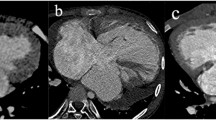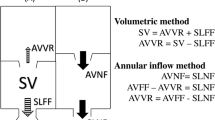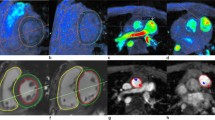Abstract
Children with right ventricular outflow tract obstructive (RVOTO) lesions require precise quantification of pulmonary artery (PA) size for proper management of branch PA stenosis. We aimed to determine which cardiovascular magnetic resonance (CMR) sequences and planes correlated best with cardiac catheterization and surgical measurements of branch PA size. Fifty-five children with RVOTO lesions and biventricular circulation underwent CMR prior to; either cardiac catheterization (n = 30) or surgery (n = 25) within a 6 month time frame. CMR sequences included axial black blood, axial, coronal oblique and sagittal oblique cine balanced steady-state free precession (bSSFP), and contrast-enhanced magnetic resonance angiography (MRA) with multiplanar reformatting in axial, coronal oblique, sagittal oblique, and cross-sectional planes. Maximal branch PA and stenosis (if present) diameter were measured. Comparisons of PA size on CMR were made to reference methods: (1) catheterization measurements performed in the anteroposterior plane at maximal expansion, and (2) surgical measurement obtained from a maximal diameter sound which could pass through the lumen. The mean differences (Δ) and intra class correlation (ICC) were used to determine agreement between different modalities. CMR branch PA measurements were compared to the corresponding cardiac catheterization measurements in 30 children (7.6 ± 5.6 years). Reformatted MRA showed better agreement for branch PA measurement (ICC > 0.8) than black blood (ICC 0.4–0.6) and cine sequences (ICC 0.6–0.8). Coronal oblique MRA and maximal cross sectional MRA provided the best correlation of right PA (RPA) size with ICC of 0.9 (Δ −0.1 ± 2.1 mm and Δ 0.5 ± 2.1 mm). Maximal cross sectional MRA and sagittal oblique MRA provided the best correlate of left PA (LPA) size (Δ 0.1 ± 2.4 and Δ −0.7 ± 2.4 mm). For stenoses, the best correlations were from coronal oblique MRA of right pulmonary artery (RPA) (Δ −0.2 ± 0.8 mm, ICC 0.9) and sagittal oblique MRA of left pulmonary artery (LPA) (Δ 0.2 ± 1.1 mm, ICC 0.9). CMR PA measurements were compared to surgical measurements in 25 children (5.4 ± 4.8 years). All MRI sequences demonstrated good agreement (ICC > 0.8) with the best (ICC 0.9) from axial cine bSSFP for both RPA and LPA. Maximal cross sectional and angulated oblique reformatted MRA provide the best correlation to catheterization for measurement of branch PA’s and stenosis diameter. This is likely due to similar angiographic methods based on reformatting techniques that transect the central axis of the arteries. Axial cine bSSFP CMR was the best surgically measured correlate of PA branch size due to this being a measure of stretched diameter. Knowledge of these differences provides more precise PA measurements and may aid catheter or surgical interventions for RVOTO lesions.



Similar content being viewed by others
Abbreviations
- RVOTO:
-
Right ventricular outflow tract obstruction
- PA:
-
Pulmonary artery
- RPA:
-
Right pulmonary artery
- LPA:
-
Left pulmonary artery
- CMR:
-
Cardiovascular magnetic resonance
- MRA:
-
Magnetic resonance angiography
- bSSFP:
-
Balanced steady state free precession
- ICC:
-
Intra class correlation coefficient of variance
- TOF:
-
Tetralogy of Fallot
- BSA:
-
Body surface area
- RV-PA:
-
Right ventricular-pulmonary artery
- APC:
-
Aortopulmonary collateral
References
Rome JJ, Mayer JE, Castaneda AR, Lock JE (1993) Tetralogy of Fallot with pulmonary atresia. Rehabilitation of diminutive pulmonary arteries. Circulation 88:1691–1698
Kreutzer J, Perry SB, Jonas RA, Mayer JE, Castaneda AR, Lock JE (1996) Tetralogy of Fallot with diminutive pulmonary arteries: preoperative pulmonary valve dilation and transcatheter rehabilitation of pulmonary arteries. J Am Coll Cardiol 27:1741–1747
Lund AM, Vogel M, Marshall AC, Emani SM, Pigula FA, Tworetzky W, McElhinney DB (2011) Early reintervention on the pulmonary arteries and right ventricular outflow tract after neonatal or early infant repair of truncus arteriosus using homograft conduits. Am J Cardiol 108:106–113
Kaza AK, Lim HG, Dibardino DJ, Bautista-Hernandez V, Robinson J, Allan C, Laussen P, Fynn-Thompson F, Bacha E, del Nido PJ, Mayer JE Jr, Pigula FA (2009) Long-term results of right ventricular outflow tract reconstruction in neonatal cardiac surgery: options and outcomes. J Thorac Cardiovasc Surg 138:911–916
Dragulescu A, Kammache I, Fouilloux V, Amedro P, Metras D, Kreitmann B, Fraisse A (2011) Long-term results of pulmonary artery rehabilitation in patients with pulmonary atresia, ventricular septal defect, pulmonary artery hypoplasia, and major aortopulmonary collaterals. J Thorac Cardiovasc Surg 142:1374–1380
Holmqvist C, Hochbergs P, Bjorkhem G, Brockstedt S, Laurin S (2001) Pre-operative evaluation with MR in tetralogy of fallot and pulmonary atresia with ventricular septal defect. Acta Radiol 42:63–69
Pagani FD, Cheatham JP, Beekman RH, 3rd, Lloyd TR, Mosca RS, Bove EL (1995) The management of tetralogy of Fallot with pulmonary atresia and diminutive pulmonary arteries. J Thorac Cardiovasc Surg 110:1521–1532; discussion 1532–1523
Beekman RP, Beek FJ, Meijboom EJ (1997) Usefulness of MRI for the pre-operative evaluation of the pulmonary arteries in Tetralogy of Fallot. Magn Reson Imaging 15:1005–1015
Valverde I, Parish V, Hussain T, Rosenthal E, Beerbaum P, Krasemann T (2011) Planning of catheter interventions for pulmonary artery stenosis: improved measurement agreement with magnetic resonance angiography using identical angulations. Catheter Cardiovasc Interv 77:400–408
Fyfe DA, Parks WJ (2002) Noninvasive diagnostics in congenital heart disease: echocardiography and magnetic resonance imaging. Crit Care Nurs Q 25:26–36
Duerinckx AJ, Wexler L, Banerjee A, Higgins SS, Hardy CE, Helton G, Rhee J, Mahboubi S, Higgins CB (1994) Postoperative evaluation of pulmonary arteries in congenital heart surgery by magnetic resonance imaging: comparison with echocardiography. Am Heart J 128:1139–1146
Ichida F, Hashimoto I, Tsubata S, Hamamichi Y, Uese K, Murakami A, Miyawaki T (1999) Evaluation of pulmonary blood supply by multiplanar cine magnetic resonance imaging in patients with pulmonary atresia and severe pulmonary stenosis. Int J Card Imaging 15:473–481
Powell AJ, Chung T, Landzberg MJ, Geva T (2000) Accuracy of MRI evaluation of pulmonary blood supply in patients with complex pulmonary stenosis or atresia. Int J Card Imaging 16:169–174
Geva T, Greil GF, Marshall AC, Landzberg M, Powell AJ (2002) Gadolinium-enhanced 3-dimensional magnetic resonance angiography of pulmonary blood supply in patients with complex pulmonary stenosis or atresia: comparison with x-ray angiography. Circulation 106:473–478
Kondo C, Takada K, Yokoyama U, Nakajima Y, Momma K, Sakai F (2001) Comparison of three-dimensional contrast-enhanced magnetic resonance angiography and axial radiographic angiography for diagnosing congenital stenoses in small pulmonary arteries. Am J Cardiol 87:420–424
Roche KJ, Rivera R, Argilla M, Fefferman NR, Pinkney LP, Rusinek H, Genieser NB (2004) Assessment of vasculature using combined MRI and MR angiography. AJR Am J Roentgenol 182:861–866
Valsangiacomo Buchel ER, DiBernardo S, Bauersfeld U, Berger F (2005) Contrast-enhanced magnetic resonance angiography of the great arteries in patients with congenital heart disease: an accurate tool for planning catheter-guided interventions. Int J Cardiovasc Imaging 21:313–322
Durongpisitkul K, Saiviroonporn P, Soongswang J, Laohaprasitiporn D, Chanthong P, Nana A (2008) Pre-operative evaluation with magnetic resonance imaging in tetralogy of fallot and pulmonary atresia with ventricular septal defect. J Med Assoc Thai 91:350–355
Bernardes RJ, Marchiori E, Bernardes PM, Monzo Gonzaga MB, Simoes LC (2006) A comparison of magnetic resonance angiography with conventional angiography in the diagnosis of tetralogy of Fallot. Cardiol Young 16:281–288
Oswal N, Sullivan I, Khambadkone S, Taylor AM, Hughes ML (2012) Cardiac magnetic resonance imaging predicts cardiac catheter findings for great artery stenosis in children with congenital cardiac disease. Cardiol Young 22:178–183
Hayes AM, Baker EJ, Parsons J, Anjos R, Qureshi SA, Maisey MN, Tynan M (1994) Evaluation of pulmonary artery anatomy using magnetic resonance: the importance of multiplanar and oblique imaging. Pediatr Cardiol 15:8–13
Canter CE, Gutierrez FR, Mirowitz SA, Martin TC, Hartmann AF Jr (1989) Evaluation of pulmonary arterial morphology in cyanotic congenital heart disease by magnetic resonance imaging. Am Heart J 118:347–354
Sievers HH, Onnasch DG, Lange PE, Bernhard A, Heintzen PH (1983) Dimensions of the great arteries, semilunar valve roots, and right ventricular outflow tract during growth: normative angiocardiographic data. Pediatr Cardiol 4:189–196
Huwez FU, Houston AB, Watson J, McLaughlin S, Macfarlane PW (1994) Age and body surface area related normal upper and lower limits of M mode echocardiographic measurements and left ventricular volume and mass from infancy to early adulthood. Br Heart J 72:276–280
Srinivas B, Patnaik AN, Rao DS (2011) Gadolinium-enhanced three-dimensional magnetic resonance angiographic assessment of the pulmonary artery anatomy in cyanotic congenital heart disease with pulmonary stenosis or atresia: comparison with cineangiography. Pediatr Cardiol 32:737–742
Acknowledgments
The authors would like to acknowledge Dr. David B Ross and Dr. Ivan Rebeyka for their great assistance in surgical measurement in Stollery Children Hospital and Dr. Kimberley A Myers who conduct MRI study in Alberta Children Hospital. We gratefully thank to administrators of the CMR imaging centres in Calgary and Edmonton, and the cardiac catheterization laboratory at t he Mazankowski Alberta Heart Institute, University of Alberta for their great assistance with the images and manuscript preparation. We also acknowledge Dr. Julaporn Pooliam, Clinical Epidemiology Unit Center, Office of Research and Development, Faculty of Medicine, Siriraj Hospital, Mahidol University for her assistance with the statistics.
Conflict of interest
The authors declare that they have no conflict of interests.
Author information
Authors and Affiliations
Corresponding author
Rights and permissions
About this article
Cite this article
Vijarnsorn, C., Rutledge, J.M., Tham, E.B. et al. Which cardiovascular magnetic resonance planes and sequences provide accurate measurements of branch pulmonary artery size in children with right ventricular outflow tract obstruction?. Int J Cardiovasc Imaging 30, 329–338 (2014). https://doi.org/10.1007/s10554-013-0328-1
Received:
Accepted:
Published:
Issue Date:
DOI: https://doi.org/10.1007/s10554-013-0328-1




